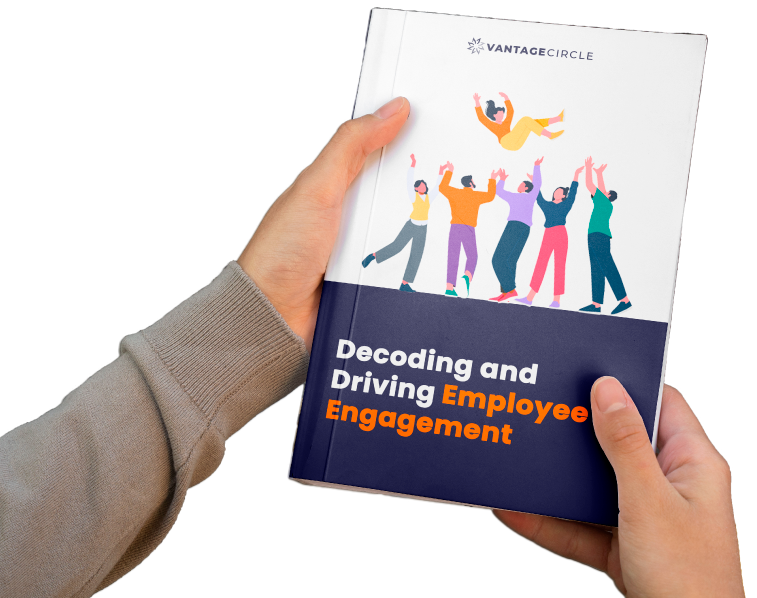The Employee Morale Survey Playbook: 50+ Questions & Your Action Plan

A Global Employee Recognition and Wellness Platform
In the early 2000s, Yahoo was a leader in the tech industry. By 2012, it was struggling, and one key reason was low employee morale. Despite its strong market presence, disengaged employees led to high turnover, poor innovation, and missed opportunities. When Marissa Mayer became CEO, she inherited a company where employees felt disconnected and unmotivated, issues she had to address quickly.
This is more than just a leadership challenge. Research from the University of Warwick shows that happy employees are 12% more productive, a stark reminder of how crucial morale is to business performance. Ignoring employee engagement can lead to high turnover, low productivity, and a stagnant workplace.
We’ll explore why employee morale surveys are crucial, how to structure an effective one, and provide you with over 50+ questions to ask your employees to gather meaningful feedback.
Key Takeaways
- What is an employee morale survey?
- Why morale surveys matter?
- 50+ employee morale survey questions
- Actionable checklist
- Conclusion
What Exactly is an Employee Morale Survey?
An employee morale survey is a short, anonymous questionnaire designed to gauge how your employees genuinely feel about their work, their workplace, and their leaders. Unlike broader employee engagement surveys, morale surveys zero in on three core areas:
- Energy
Are employees energized and enthusiastic about their tasks, or are they drained and overwhelmed? Understanding energy helps you address burnout early, before productivity slips.
- Purpose
Do employees clearly see how their daily work connects to the company's larger goals? Research consistently shows that when people feel their work matters, performance and satisfaction soar.
- Trust
Do employees feel safe to speak up, ask questions, or admit mistakes without fear of negative consequences? Google’s extensive "Project Aristotle" research identified psychological safety as the single most important factor driving effective, high-performing teams.
Employee morale surveys are most effective when run regularly, quarterly is a common cadence and kept short (around 10 questions, taking less than 5 minutes). To maintain trust, ensure responses remain confidential or anonymous, and clearly communicate that the data collected will drive meaningful action.
TL;DR - A short, anonymous pulse that checks energy, purpose, and trust—run it quarterly, share results fast, fix something right away.
Employees who believe that management is concerned about them as a whole person – not just an employee – are more productive, satisfied, and fulfilled. Satisfied employees mean satisfied customers, which leads to profitability
– Anne M. Mulcahy
50+ Questions for Your Employee-Morale Survey
Below are 55 ready-to-use questions, grouped by theme. Mix and match 8–10 each quarter so the survey stays short (≤10 minutes) while still covering the essentials.
1. Workplace Energy
-
I start most workdays feeling refreshed.
-
My workload is sustainable week to week.
-
I have the right tools to do my job well.
-
Team processes help more than they hinder.
-
When I’m stuck, I can get help quickly.
Send these questions mid-week. Mondays can feel falsely upbeat and Fridays can feel drained; a Wednesday snapshot usually captures everyday reality. A two-pulse drop on Q1 or Q2 is your first burnout alarm.
- Purpose & Meaning
-
I see how my work contributes to company goals.
-
Our mission still excites me.
-
I’m proud to tell friends I work here.
-
Leaders share real customer stories that show our impact.
-
My tasks feel important, not just busywork.
Include a short customer-success story in your survey email. It nudges employees to think about impact, not just tasks, and lifts response quality.
- Leadership & Trust
-
Senior leaders communicate a clear plan.
-
Words and actions match at the top.
-
I trust leaders to act on survey feedback.
-
Big decisions are explained promptly.
-
Mistakes are acknowledged, not hidden.
Share these results with executives 48 hours before anyone else so they can prep answers. A quick, transparent follow-up AMA turns skepticism into trust
4. Manager Support
-
My manager recognises good work quickly.
-
Feedback I get is specific and useful.
-
I can discuss mistakes without fear.
-
My manager helps remove roadblocks.
-
I feel cared for as a person, not just a role.
Give every manager a one-page “team snapshot” and a coaching template. When they walk into 1-on-1s with a plan, scores rebound faster.
5. Growth & Development
-
I see a clear path to advance here.
-
I’m encouraged to learn new skills.
-
My strengths are used every day.
-
I get time for professional development.
-
Internal job moves are transparent and fair.
Cross-check these answers with internal-mobility data. If people feel stuck but openings exist, the problem is communication, not opportunity.
6. Recognition & Rewards
-
Outstanding work is celebrated publicly.
-
My pay feels fair for what I contribute.
-
Non-monetary kudos happen often.
-
I understand how bonuses or raises are decided.
-
Benefits fit my life stage and needs.
Low scores jump quickest when you launch a peer-to-peer shout-out channel. It costs nothing and starts paying off in days.
7. Team Connection
-
My teammates share knowledge freely.
-
Conflicts are resolved quickly and respectfully.
-
Collaboration across teams is smooth.
-
Meetings end with clear decisions and owners.
-
I can ask anyone for help and expect a response.
When this section shines, invite that team to demo its rituals at the next all-hands. Good habits spread faster than new software.
8. Autonomy & Flexibility
-
I can adjust my hours when life happens.
-
I’m trusted to choose how to do my job.
-
Our tools make hybrid or remote work easy.
-
Deadlines feel realistic for the scope of work.
-
I control enough of my schedule to stay focused.
Break results down by location. What feels flexible to HQ may feel rigid to satellite offices.
9. Psychological Safety
-
I can voice a dissenting opinion without backlash.
-
It’s safe to admit I don’t know something.
-
People here treat each other with respect.
-
Risk-taking is encouraged, not punished.
-
Leaders model vulnerability in meetings.
Track the trend, not the single number. A steady slide here predicts innovation slowdowns and turnover six months out.
10. Well-Being & Inclusion
-
I feel comfortable being myself at work.
-
Company policies support mental health.
-
Wins are celebrated in ways that include everyone.
-
Leadership roles show real diversity.
-
Everyday language and imagery feel inclusive.
Share anonymized themes with your DEI and benefits teams within 24 hours. Fast handoffs show employees these answers matter.
11. Open-Ended Prompts
-
One change that would improve my workday is…
-
A recent moment that made me feel valued was…
-
My biggest blocker right now is…
-
A process we should retire is…
-
A small win we should recognise is…
Limit to two open-ended questions per pulse. Leaders actually read them, employees stay willing to write them, and insights stay crisp.
TL;DR - Eleven themed sets you can mix-and-match into a 10-minute survey, each with a quick tip to get clearer answers.
Why Morale Surveys Are Crucial for Your Business?
Why should you prioritize employee morale surveys? Let’s break it down with real-world data that you can’t afford to ignore.
1. Identify strengths
Spot what really works: High scores reveal the teams and habits already lifting energy and results.
Share winning playbooks: Ask those teams to show others the small rituals that keep them motivated, like a five-minute “win round” during stand-up.
Build momentum: Praising what’s strong tells employees their best efforts matter and sets a clear standard for everyone else.
2. Uncover Weaknesses
Find the quiet pain points: Low scores on clarity, workload, or trust often show up before missed deadlines or resignations.
Fix issues early: A quick conversation and one visible change, removing a pointless approval step, for instance, can reverse a slump faster than any perk.
Protect morale equity: When people see problems addressed promptly, they feel safe speaking up the next time.
3. Enhance engagement
Turn feedback into fuel: When employees notice their ideas shaping policy, they lean in harder and care more about outcomes.
Keep purpose front and center: Pair survey results with real customer stories so teams connect their daily tasks to lives improved outside the building.
Watch enthusiasm ripple: Genuine engagement spreads; one team’s renewed energy nudges neighboring teams to raise their game.
4. Reduce turnover risk
Catch early signs of flight: A dip in purpose or manager support often comes months before someone starts job hunting.
Run stay interviews, not exit interviews: A ten-minute chat paired with a clear action plan shows you value that employee enough to listen now, not after they leave.
Save real money: Retaining skilled staff avoids the recruiting cost and productivity pause that come with backfilling roles.
5. Strengthen leadership
Give managers real-time coaching data: They see exactly where their teams feel heard, and where they don’t.
Target development dollars: Focus training on the specific skills each manager needs, instead of one-size-fits-all workshops.
Grow trust by being transparent: Sharing manager-level results privately lets leaders own their growth areas without public shaming.
6. Improve decision speed
Spot bottlenecks fast: Low scores on “decision clarity” highlight where approvals stall and projects languish.
Streamline workflows: Removing a single layer of sign-off can shave days off a project timeline and lift morale in one move.
Keep teams moving forward: Quick wins build confidence that leadership listens and acts, making employees more likely to surface future roadblocks.
TL;DR - Surveys reveal strengths to amplify, weak spots to repair, and early warnings that save money, talent, and time.
Action Checklist: From Survey to Success
Surveys are just the beginning. To turn data into meaningful change, follow this action checklist:
1. Communicate the Purpose
Tell people why you’re asking for their input before the survey lands in their inbox. A 90-second video from the CEO beats a long email, employees see a face, hear the intent, and know the survey isn’t just HR busywork.
2. Guarantee Anonymity and Confidentiality
If responses aren’t truly anonymous, honesty disappears. Use a trusted third-party tool like Vantage Pulse or Officevibe or strip identifying data before anyone on your team sees the results. Then say so, clearly.
3. Design a Balanced, Concise Survey
Ten minutes max. Mix five core questions you track every quarter with a rotating set that probes current priorities. Long, repetitive forms lead to rushed clicks and bad data.
4. Analyze for Actionable Trends, Not Just Data
Look past the averages. Slice scores by team, location, tenure, and role to spot pockets of pain or pockets of excellence. A single under-resourced group can drag the whole average down, and fixing it is faster than launching a company-wide program.
5. Share the Results and Close the Loop
Publish a one-page summary within two weeks: top three wins, top three pain points, and one concrete step already underway. The speed shows respect and builds trust for the next survey.
6. Act Visibly and Follow Up
Choose one low-lift fix per pain point, removing a pointless approval step, piloting meeting-free Wednesdays, launching a micro-recognition channel. Announce the change, set a 30-day check-in, and measure the shift in the next pulse.
TL;DR - Six steps after “Submit”: explain why, protect anonymity, keep it short, slice the data, close the loop in two weeks, and make one visible change.
Conclusion
Employee-morale surveys might feel like “just another HR survey,” but to the people filling them out, they’re the clearest proof that their voices still matter. When you ask sincerely, and then act, you turn a routine questionnaire into a trust-building ritual. One pulse shows you the hot spots. Two pulses reveal the trend. Three pulses make improvement a habit the whole company can feel.
Treat the survey as a standing conversation: Listen, respond, adjust, repeat. Do that, and morale data stops being numbers on a dashboard and becomes the fuel that keeps talent engaged, innovation alive, and your culture unmistakably real.

















